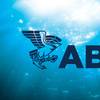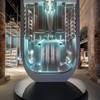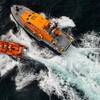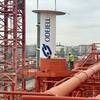First Fire Prevention Notation in Cruiser
Cruise operator Royal Caribbean International (RCL), Finnish technology major Wärtsilä, and DNV GL announced that Navigator of the Seas, the Voyager-class cruise, will feature the industry's first fire prevention notation.
Even though great strides have been taken in detecting, containing and extinguishing fires, the best time to fight a fire is before it starts.
The desire to work towards a zero-fire engine room led cruise operator RCL, technology group Wärtsilä, and classification society DNV GL to initiate a joint industry project to improve engine room fire prevention.
Since 2016, the partners have worked with stakeholders across the whole industry to collect data, analyse the key risks, and develop safety barriers to manage the most significant risk factors. As a result, RCL launched a program to enhance engine room fire prevention across its entire fleet and Wärtsilä offered technical solutions and procedures for the maintenance of their engines to lower fire risk. DNV GL has introduced a new class notation F(M-P), which focuses not only on the systems, but the processes and people to enhance the main safety barriers to prevent fires in machinery spaces.
“Our target is zero engine room fires and with these enhanced standards, we believe this goal is within reach,” said Anders Aasen, VP of Global Technical Solutions at RCL.
“Any fire, even one that is detected and extinguished immediately, can impact not only the ship, but the operator and the whole industry. This is why we are so pleased that the cruise ship safety forum, alongside many other stakeholders, could come together around a set of best practices that strengthen safety barriers and were published in January this year. For RCL, this project has had the added benefit that we have enhanced our data analytics capabilities, which gives us an ongoing scope for further improvement,”he added.
“This particular case has proven the power of cooperation between the customer and the supplier in order to take the next steps in safety,” said Jyrki Salo, Senior Product Manager (SOLAS) at Wärtsilä.
“The creation of the 150°C design has its roots in the safety charrette held three years ago, where we worked on ideas for increasing safety in the cruise industry. Developing a successful SOLAS compliant product is a result of numerous design improvements. Wärtsilä’s long history of retrofit SOLAS compliant designs has resulted in a solution which allows going below 150°C. We have also used the lessons we have learned from earlier designs and adapted the new designs accordingly,” Salo added.
The new DNV GL class notation F(M-P), which will be implemented in RCL’s new cruise vessel Navigator of the Seas, identifies key areas for preventing fires in engine rooms based on incident analysis, feedback from surveyors, and best practices from the industry.
It sets in place standards and processes focussing on the prevention, detection and containment of oil leakage, the shutdown of system, as well as the prevention of ignition.
“The new notation brings together many aspects of barrier management to improve safety,” said Knut Ørbeck-Nilssen, CEO of DNV GL – Maritime.
“It covers not just the technical systems, but the processes used and the people involved, utilising best practices to provide a holistic approach to preventing these incidents. This notation shows the importance of learning from casualty data, and how by combining this with the insights from class and the industry we can work together to move safety forward,” he said.
As casualty statistics indicate that many engine room fires occur when flammable liquid reaches a hot surface, the notation introduces process checks and technical measures to prevent this from occurring.
There is overarching emphasis on both internal and external processes and procedures, with auditing of procedures to enable more efficient oversight. Likely areas for leakage are identified, and containment strategies for such areas offered.
Control and monitoring of vibration in essential systems is an added requirement, with ongoing data collection included to show trends over time. Insulation of potentially hot surfaces is also a key issue to prevent ignition, so maintenance activities in this area are emphasised.
In addition, the requirement for continuous improvement through data analytics means that owners and operators can gain ongoing benefits from the processes and systems they put in place to prevent fires.










